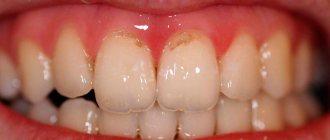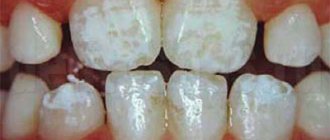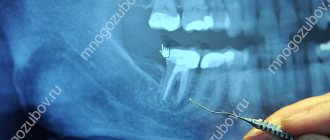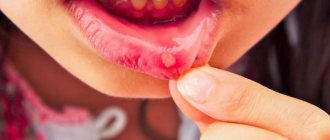Periodontitis
Diabetes
Atherosclerosis
2131 August 26
IMPORTANT!
The information in this section cannot be used for self-diagnosis and self-treatment.
In case of pain or other exacerbation of the disease, diagnostic tests should be prescribed only by the attending physician. To make a diagnosis and properly prescribe treatment, you should contact your doctor. Periodontitis: causes, symptoms, diagnosis and treatment methods.
Periodontitis is a chronic inflammatory disease of the dental system, which is accompanied by the gradual destruction of the tissues surrounding the tooth (periodontal tissue) and a decrease in the volume of the bone tooth socket (alveoli) and the entire alveolar ridge. The name “periodontal disease” is considered outdated, but implies processes similar to periodontitis.
Most often, the disease has a chronic course, accompanied by the appearance of deposits on the teeth, redness and bleeding of the gums, the formation of deep periodontal pockets and pathological mobility of the teeth.
Gradually, this leads to tooth loss in an adult and contributes to the development of pathological processes in the body. Complications of periodontitis can include sinusitis, osteomyelitis, and diseases of the cardiovascular system.
Causes of periodontitis
Periodontitis is a multifactorial disease, meaning it can occur for many reasons. Acute periodontitis (periodontitis) is less common than chronic and is most often the result of mechanical or chemical trauma to the periodontal junction. An abscess (ulcer) appears on the gum, which can lead to the appearance of a fistula (a canal connecting the abscess cavity with the external environment).
Chronic periodontitis often develops as a result of poor oral hygiene, when the activity of oral microorganisms increases.
Soft and hard deposits on teeth are a biofilm, which also includes pathogenic bacteria. Their activity can lead to inflammation of the gums (gingivitis), periodontium (tissues surrounding the root of the tooth) and alveolar bone tissue. The inflammatory reaction leads to the gradual destruction of the ligamentous apparatus of the teeth. The necks of the teeth become exposed, and the teeth gradually become loose and fall out.
Local factors causing the occurrence of periodontitis include overload of the periodontium due to malocclusion due to crowding of teeth, poor prosthetics or loss of a group of teeth. The habit of clenching your jaw tightly and grinding your teeth also leads to overload and inflammation of the periodontium.
The development of periodontitis can be caused by a narrowing of the lumen of blood vessels due to diabetes mellitus, atherosclerosis, changes in the composition of saliva, and tissue swelling that occurs due to endocrine disorders.
In addition, the role of vitamin deficiency in periodontal diseases has been proven. Thus, hypovitaminosis C leads to fragility of blood vessels, decreased collagen synthesis, which weakens the ligaments of the teeth, and a general weakening of the immune system.
Classification of periodontitis
Depending on the clinical symptoms and speed of development of the disease, periodontitis is divided into acute and chronic. An acute process, accompanied by pain and bleeding of the gums, develops within a few days after physical or chemical trauma, most often soon after the placement of a filling, crown or other orthodontic structure. If left untreated, acute periodontitis can be complicated by a fistula. However, in most cases, the acute process is replaced by a chronic one, which can last for several years. In this case, the period of attenuation of clinical symptoms due to provoking factors is replaced by a relapse.
In most cases, the disease becomes chronic from the very beginning. This is facilitated by poor oral hygiene and the formation of soft and hard deposits on the teeth. Chronic periodontitis begins gradually and spreads to the entire surface of the gums, then it is called generalized.
If bleeding gums are observed periodically and are caused by brushing teeth and eating hard foods, a diagnosis of mild periodontitis is made.
With increased bleeding, pain, loosening and loss of teeth, moderate and severe degrees of generalized periodontitis are noted.
Symptoms of periodontitis
In acute periodontitis, pain, swelling and bleeding of the gums develop within a few days after exposure to a traumatic factor. As a rule, pain occurs not only when biting, but also outside of chewing load. It is possible for an abscess to form in the area of the “causal” tooth, which breaks through to form a fistula. If the traumatic factor is not eliminated (remove the crown, remove excess filling), the fistula can become a permanent outlet for pus accumulated in the gingival abscess.
Symptoms of chronic periodontitis develop gradually.
However, over time, mild pain when brushing teeth and chewing becomes commonplace. Bleeding becomes constant, the gums change color, and the necks of the teeth become exposed. The periodontal pockets, which can be measured with a dental probe, deepen. There is an unpleasant odor from the mouth, a burning sensation, pain in the gums and jaws, which intensifies when the teeth are closed. Painful pustules may form under swollen gums. Eating becomes difficult. Gradually, the necks of the teeth are exposed, the bone sockets in which the teeth are attached are reabsorbed, then the teeth become loose and easily fall out.
Diagnosis of periodontitis
First of all, a clinical blood test and a biochemical blood test are needed to assess metabolic processes (total protein, protein fractions, C-reactive protein, ALT, AST, LDH, creatinine, electrolytes: potassium, sodium, chlorine, calcium) and urine for differential diagnosis with inflammatory processes caused by blood diseases (leukemia, agronulocytosis, aplastic anemia, thrombocytopenic purpura) or various diseases of internal organs (including endocrine ones - diabetes mellitus, dysfunction of the liver and kidneys, etc.).
Features of the initial stage of treatment of patients with severe periodontitis
T. V. Zakirov Ph.D., Associate Professor, Department of Pediatric Dentistry and Orthodontics, USMU
Periodontitis is one of the diseases with mild symptoms in the initial stages of its development. Typically, the only symptom of mild periodontitis is bleeding gums when brushing your teeth. Over time, this symptom disappears, and the disease does not manifest itself for a long time.
By the time severe periodontitis develops, the patient accumulates a whole complex of problems in the form of a pronounced loss of supporting-retaining periodontal tissues, pathological mobility and displacement of teeth, endo-periodontal lesions develop, periodontally altered occlusion, and occlusion of the dentition is disturbed [2, 7].
The condition is aggravated by the presence of concomitant somatic diseases in patients. These patients usually turn to the doctor at the stage of severe exacerbation of the inflammatory process in the periodontium with the presence of symptoms such as suppuration from periodontal pockets, sometimes abscess formation, severe tooth mobility, bad breath, etc. (Fig. 1, 2).
rice. 1. Oral cavity of a 30-year-old female patient with exacerbation of severe periodontitis. rice. 2. OPTG of the same patient, pronounced resorption of alveolar bone tissue.
The further prognosis for the entire human dental system often depends on the correct tactics of the dentist at this first stage. Unfortunately, in clinical practice, the choice of a doctor often takes one of the marginal positions: either total removal of teeth with subsequent problems with prosthetics, or, conversely, preservation of teeth in the absence of periodontal treatment as such. The situation is aggravated by the fact that the treatment of such patients requires the participation of almost all dental specialists, and the severity of the existing problems requires highly qualified doctors. In most cases, the first stage involves superficial cleaning of dental plaque.
Often this manipulation is performed by a clinic hygienist with secondary medical education. It should be noted that in the case of severe periodontitis, such tactics are unacceptable, because it inevitably leads to low effectiveness of the treatment, increases the likelihood of local and general complications, and makes it difficult to plan a further set of treatment measures. Patients, not seeing a significant improvement in the condition of their gums, lose confidence in the team of specialists and refuse recommended treatment measures (Fig. 3, 4). Therefore, knowledge of the features of managing patients with severe inflammatory periodontal diseases plays an extremely important role both in achieving clinical success at the initial stage of treatment and in planning further comprehensive dental rehabilitation.
rice. 3. Persistence of gum inflammation 1 month after professional hygiene in another clinic, right view. rice. 4. Oral cavity of the same patient, left view.
The first stage of treatment for patients with periodontal diseases should begin with a detailed conversation. During this period, the doctor must receive comprehensive information about the patient’s health status, medications he is taking, dietary habits and oral hygiene. Particular attention is paid to allergic diseases, diseases of the blood system with impaired coagulation, the speed of wound healing (regeneration can be suppressed due to diabetes mellitus, taking cytostatics, immunosuppressants, hormones; the risk of jaw necrosis is sharply increased when taking medications from the group of bisphosphonates, etc.). Despite the banality of this stage, it must be remembered that only the most detailed informing the doctor about the patient’s health status will help in the future to prevent the occurrence of serious complications in the form of unexpected bleeding, suppuration or extensive necrosis of periodontal tissue (Fig. 5).
When examining the patient, a periodontal card is filled out with a detailed indication of the depth of the periodontal pockets, the degree of gum recession, tooth mobility, the degree of furcation damage, etc. Hygienic and periodontal indices are assessed, as well as, if possible, the gum bleeding index. It is better to photograph the patient’s oral cavity before treatment and at the stages of complex therapy. Considering the constant increase in the legal literacy of patients, the increasing number of cases of defending their rights in court and the high cost of dental treatment, this stage is of particular importance.
The fact is that patients and doctors evaluate some results of treatment of moderate periodontitis completely differently. If the doctor pays attention to a decrease in the depth of periodontal pockets, a decrease in gum swelling and a decrease in exudation, then for the patient the leading symptom after the treatment will be exposure of the roots, loosening of the teeth and increased sensitivity (Fig. 6, 7).
rice. 5. Necrosis of the gums after professional hygiene due to 10 years of taking methotrexate. rice. 6. View of the gums before treatment in severe aggressive periodontitis. rice. 7. Generalized gum recession 1 month after the first stage of treatment.
Naturally, these symptoms are assessed sharply negatively by patients, so the patient should be warned about their development in advance when signing informed consent. In this case, emphasis should be placed on the temporary nature of the changes that occur. Increased sensitivity gradually disappears, pathological mobility of teeth also decreases, and gingival papillae are fully or partially restored while maintaining the distance from the contact point to the alveolar ridge within 5-7 mm [8]. In severe periodontitis, these changes are irreversible, but the doctor must focus on their cause (advanced periodontitis and loss of a large amount of tissue as a result of a long-term inflammatory process in the periodontium), as well as on the possibility of completely eliminating or leveling these symptoms at subsequent stages of treatment (splinting teeth, restoration, etc.). In other words, forewarned means forearmed.
The actual treatment of a patient with severe periodontitis must begin with empirical antibiotic therapy. The pronounced stage of inflammatory periodontal disease is characterized by deep massive invasion of aggressive anaerobic bacteria not only into the tissue of the periodontal complex and other organs and tissues of the oral cavity (for example, periodontal pathogenic microorganisms are found in the folds of the tongue, tonsil crypts, epithelial cells of the mucous membrane), but also in remote regions of the human body. body (endocardium, atherosclerotic vascular plaques, etc.).
In addition, after professional hygiene in severe periodontitis, a fairly large number of microorganisms are released into the blood - the phenomenon of transient bacteremia occurs [3]. And if in most patients this is accompanied by a feeling of weakness, malaise and a slight increase in body temperature, then in patients at risk (prosthetic heart valves and joints, congenital or acquired endocardial defects, etc.) this can lead to such serious complications as bacterial endocarditis or even sepsis [4].
Therefore, only systemic antibiotic therapy will suppress the majority of pathogenic microbes in the biofilm on the root surface, significantly increase the effectiveness of treatment, improve the healing period after dental intervention, and prevent the occurrence of local and general complications [6].
The drugs of choice include antibiotics such as Tsifran ST (a combination of ciprofloxacin and tinidazole) 1 tablet. 2 times a day, amoxiclav (amoxicillin and clavulanic acid) 375 mg, 1 tablet. 3 times a day, doxycycline 100 mg 2 times a day. Usually, at the stage of exacerbation, it is enough to prescribe drugs for 5-7 days. For patients wary of antibiotic therapy, more modern once-daily medications can be recommended, such as sumamed (azithromycin) 500 mg for 3 days or avelox (moxifloxacin) 400 mg for 5 days. In this case, the minimum inhibitory concentration of the antibacterial drug will be maintained in the patient’s body for a week.
Antibiotic therapy should be started 1-2 days before professional oral hygiene. Key point: the main treatment of periodontal pockets, even if it is divided into several stages, should involve taking antibiotics. It is important to focus the patient’s attention on the need to take an antibiotic; to increase motivation, you can show him suppuration from the pockets by applying finger pressure to the gums.
Of course, antibiotic therapy is a serious medical intervention in the human body, so it must be carried out in compliance with all the basic requirements of chemotherapy, taking into account the patient’s health status, indications and contraindications, and under the constant supervision of a physician. To minimize the side effects of antibacterial drugs, it is necessary to prescribe in parallel the administration of eubiotics for 2 weeks (Linex, Bifiform, Acipol, etc.).
It is better to carry out the treatment of periodontal pockets in 2 visits, separately for the upper and lower jaws, although under certain conditions (small number of teeth, remote place of residence of the patient) all the work can be carried out in one visit. Before use, the patient should rinse the mouth with an antiseptic, for example 0.2% chlorhexidine, which will reduce the contamination of the bacterial aerosol generated when using ultrasonic devices.
A prerequisite for effective pocket work in the vast majority of patients is adequate pain relief. A priori, it is impossible to treat the root surfaces to the full depth when using topical anesthesia. To increase the effectiveness of anesthesia in the lateral areas of the lower jaw, anesthetic injections are carried out not in the area of the transitional fold, but in the area of the attached gum. This promotes better deposition of the anesthetic and its penetration through the cortical plate of the jaw.
Considering the number of injections, it is necessary to periodically replace the needle to reduce trauma and pain when puncturing the mucous membrane. In the case of particularly massive jaws and significant destruction of bone tissue in the area of the interdental septa, conduction anesthesia may be the method of choice.
Treatment of periodontal pockets at the first stage of treatment of periodontitis should include not only the removal of dental plaque above and below the gum, but also smoothing the surface of the roots, correction of overhanging fillings in contact areas, removal of granulations, rinsing with antiseptics and, if necessary, in especially problem areas, should be completed by applying local antibacterial drugs in addition to systemic antibiotic therapy. It should be noted that, contrary to the opinion of many doctors, removal of deposits is not the only goal of this procedure. In case of aggressive periodontitis, for example, hard dental deposits may be completely absent, however, despite this, the pathological process is characterized by a highly pronounced destructive effect on periodontal tissue, rapid progression and low effectiveness of treatment [1].
There are often cases when patients undergo vector therapy 4 times a year, but this does not lead to any significant improvement in the condition, and sometimes (for example, with simultaneous orthodontic movement of teeth) it even ends catastrophically (Fig. 8, 9).
rice. 8. Severe inflammation of the gums with ineffective regular vector therapy. rice. 9. Progressive bone resorption as a result of orthodontic treatment.
A much more important goal of working in periodontal pockets is to remove a large amount of inflammatory granulation tissue, suppress the activity of periodontopathogenic microflora and shift the biocenosis of periodontal pockets towards less aggressive saprophytic species. It is necessary to begin work with ultrasonic devices, which remove the bulk of dental plaque. Without dwelling on the principles of operation of these devices, it should be noted that the treatment should be carried out to the entire depth of the periodontal pocket. In this case, partial separation of the granulation tissue occurs, and it is then easier to remove it with hand instruments. The mandatory set of tools when treating pockets includes not only ultrasonic devices, but also periodontal burs and curettes (Fig. 10, 11).
rice. 10. Burs for working in periodontal pockets. rice. 11. Comparison of the working parts of the scaler, universal curette and Gracie curette.
Without hand tools, periodontal pockets are not treated all over the world, although the choice of a specific set of tools remains at the discretion of the specialist [5]. The main characteristics of such instruments are a rounded, non-aggressive tip (for working in the subgingival area) and sharp working edges. Today there are enough opportunities for regular sharpening of curettes, which can be carried out both in specialized centers and independently in a dental clinic (Fig. 12, 13).
rice. 12. Device for sharpening periodontal curettes. rice. 13. Checking the sharpness of hand tools.
When working with hand instruments, involuntary dissection of the gingival papillae in the interdental area is possible. In most cases, this does not require suturing: in conditions where the mucoperiosteal flap is not peeled off, the papillae, after the end of the procedure and the onset of hemostasis, take their original position and the postoperative period proceeds without any complications. We also do not recommend applying periodontal dressings. In conditions of inflammation, they only interfere with the healing process - they compress the swollen gum tissue, impede the free evacuation of the contents of periodontal pockets, and again create conditions for the growth of anaerobic microflora.
Despite the fact that modern devices sometimes have built-in methods for detecting hard dental deposits, the best method for diagnosing them remains probing the root surface with a periodontal probe.
Elements of curettage require certain skills, and this procedure can be carried out by a doctor with a higher medical education, regardless of his profile - this can be done either by a therapist or dental surgeon specializing in the treatment of periodontal diseases, or by a periodontist at a clinic (let me remind you that the specialty There is no periodontist in Russia). Due to the increased invasiveness, it is unacceptable to entrust this treatment to a hygienist: this will not only be ineffective, but in some cases it is dangerous for the health and life of the patient.
The result of a correctly carried out first stage of periodontitis treatment is a significant improvement in the condition of periodontal tissues. Regardless of the severity of the disease, the gums acquire a pale pink color, active exudation and suppuration from periodontal pockets stop, tooth mobility decreases, and bad breath disappears (Fig. 14, 15).
rice. 14. Severe periodontitis in the acute stage in a patient. rice. 15. View 1 month after the initial stage of treatment, relief of inflammation.
Patients usually note an improvement in their condition. It should be noted that sometimes, with particularly deep periodontal pockets and severe bleeding gums, it is not possible to carry out full treatment in one visit. In this case, the remnants of dental plaque and granulations can be removed after 3-4 weeks under conditions of better visibility, after the inflammatory phenomena have subsided. The only condition is that it is necessary to timely assess the severity of the disease, the amount of deposits on the teeth and warn the patient about the need for a two-stage procedure.
After a month, you can take repeated photographs of the oral cavity and gather a consultation of specialists to develop a further treatment plan. Obviously, in conditions of stopping the acute inflammatory process in the periodontium, it is easier for doctors to assess the current clinical situation, the true mobility of the teeth, and the resulting gum recession. From experience, it can be noted that even with further surgical treatment using modern osteoplastic materials and membranes, recession, if increased, is very slight, and in some cases the degree of root exposure can even be reduced by carrying out orthodontic treatment or bringing the contact point closer to the gingival papilla (Fig. 16, 17).
rice. 16. Severe gum recession with abnormal position of teeth against the background of periodontitis. rice. 17. Reduction of gum recession after orthodontic treatment.
Only when remission of the inflammatory process in the periodontium is achieved can a correct, informed decision be made on further therapeutic measures [9]. Thus, an orthodontist will be able to assess the possibility of moving teeth, and an orthopedic dentist will be able to assess the possibility of using teeth as a support for fixed dentures. Sometimes the effectiveness of deep cleaning of the gums is so high that there is no need for surgical interventions with flaps and the time for complex rehabilitation of the human dental system is significantly reduced. The effectiveness of the following stages of treatment also increases.
For example, even in the case of a surgical intervention with a flap, the surgeon will not spend additional time removing dental plaque, which, in conditions of generalized lesions, will certainly significantly reduce the operation time. Regardless of the preservation of the tooth, the procedure for regenerating bone tissue or preserving the volume of the socket will be more effective, since bone formation will occur in the absence of an inflammatory process, the retaining function of the sutures will also increase due to the restoration of the original gum density (Fig. 18-22).
rice. 18. Abscess formation in the area of the 11th tooth with severe periodontitis. rice. 19. View 1 month after professional hygiene. rice. 20. View 5 months after the removal of teeth 12 and 11 with osteoplasty of the sockets. rice. 21. View 2 years after prosthetics on implants. rice. 22. Look when smiling.
Thus, a correctly carried out first stage of treatment of moderate periodontitis creates conditions for increasing the effectiveness of complex dental rehabilitation, reduces the likelihood of complications and increases patient confidence in the team of specialists.
Information about the author Zakirov Taras Valerievich, Ph.D., Associate Professor of the Department of Pediatric Dentistry and Orthodontics, USMU (Ekaterinburg)
Zakirov TV, Ph.D., Assistant, Department of Pediatric Dentistry and Orthodontics, UGMA
Features of the initial stage of treatment of patients with severe periodontitis
Annotation. Periodontitis is one of the diseases with mild symptoms in the initial stages of its development. Typically, the only symptom of mild periodontitis is bleeding gums when brushing your teeth. Over time, this symptom disappears, and the disease does not manifest itself for a long time.
By the time severe periodontitis develops, the patient accumulates a whole complex of problems in the form of a pronounced loss of supporting-retaining periodontal tissues, pathological mobility and displacement of teeth, endo-periodontal lesions develop, periodontally altered occlusion, and occlusion of the dentition is disturbed.
Annotation. Periodontitis is one of the diseases with mild symptoms at the initial stages of its development. Usually the only symptom of mild periodontitis is bleeding gums when brushing your teeth. Over time, this symptom disappears, and for a long time the disease does not manifest itself.
By the time severe periodontitis develops, the patient has accumulated a whole range of problems in the form of pronounced loss of periodontal supporting and retaining tissues, pathological mobility and tooth dislocation, endoperiodontal lesions, periodontal malocclusion develop, and occlusion of the dentition is impaired.
Key words: periodontitis, empirical antibiotic therapy, periodontal pocket, granulation tissue
Keywords: periodontitis, empirical antibiotic therapy, periodontal pocket, granulation tissue
Stages
During the course of the disease, there are three main stages, which differ in the nature and severity of symptoms. These are the next stages.
- First. Periodontal pockets are still shallow - up to 3 mm. Periodically, after brushing, bleeding gums are noted. It is not accompanied by pain or loosening of teeth.
- Second. The depth of the pockets increases to 5 mm, due to which the neck of the tooth is partially exposed. Hypersensitivity also occurs when eating hot or cold foods.
- Third. This stage, with a non-aggressive course of the disease, develops approximately 4-5 years after the onset of inflammation. In severe cases, the dental pockets deepen up to 6 mm. Food debris accumulates in them, which leads to suppuration. This causes the teeth to become very loose.
Symptoms and signs
Periodontal inflammation is rarely accompanied by pain. More often the disease manifests itself in the form of swelling and redness of the gums. They may experience bleeding, and sometimes a local increase in temperature is observed. At an early stage, it is difficult to recognize the disease. Most patients go to the doctor with complaints of bleeding gums while brushing their teeth or eating.
If the disease is not treated, the gums subsequently begin to separate from the teeth, causing them to become longer. Significant gaps appear between the teeth. They fall out at a later stage of the disease. Other characteristic symptoms of periodontitis:
- bad breath;
- purulent discharge on the gums;
- chronic toothache;
- plaque on teeth;
- viscous saliva;
- increased gum sensitivity;
- yellow plaque on the root part of the enamel;
- sensation of pulsation in the gums.
These symptoms also affect the general condition of a person. Sometimes general weakness and headache appear, and the temperature rises.
Diagnostics
The first stage of diagnosis is an external examination of the oral cavity. The specialist performs probing (periodontal test) - a procedure that will determine the depth of the formed dental pocket. This is necessary to establish the severity of periodontitis. Additionally, the following studies are prescribed:
- benzidine test. Allows you to identify pus in periodontal pockets without performing a microscopic examination. To do this, turunda soaked in a solution consisting of benzidine, acetic acid and polyethylene glycol is inserted into the pocket. If there is no pus, then the color of the turunda does not change, but if it is present, it becomes blue, green or bluish-green;
- Schiller-Pisarev test. It is aimed at identifying glycogen in the gums, a substance whose amount increases sharply during inflammation. The gums are lubricated with a modified Lugol's solution, after which the color is assessed. It changes from light brown to dark brown;
- radiography. In the image, the specialist determines how much the bone tissue is affected by the pathological process;
- swab from a dental pocket. The study is carried out to determine the causative agent of the disease that caused the inflammatory process;
- panoramic tomography. This procedure allows you to get a complete view of the affected jaw. The study is often carried out if generalized periodontitis is suspected.
Symptoms of periodontitis disease
Periodontal disease and periodontitis are gum diseases. Patients often confuse the names of pathologies, although periodontal disease and periodontitis are different diseases in terms of development, causes of origin, and treatment methods. Both dental ailments are serious disorders that require attention and timely treatment. In its advanced form, these pathologies cause unpleasant symptoms and lead to the loss of several units of teeth. Therefore, identifying a predisposition to the development of diseases, eliminating potential and obvious causes, knowledge about these pathologies and seeking professional help will help to avoid serious consequences and progression of the situation.
The most common gum disease is periodontitis. Proper oral care and a balanced diet play a significant role in the development of the disease. The disease develops due to the complex influence of several factors: · unfavorable changes in the balance of normal and harmful microflora in the oral cavity; · decreased immune protective functions of the oral mucosa; · stress, high fatigue, exhaustion; · age-related tissue changes (nutrition of periodontal tissues deteriorates for natural reasons).
A special feature of periodontal disease is its hereditary component. There is a tendency towards a predisposition to developing the disease among relatives. If this pathology is detected in older family members, then the likelihood of manifestation in children is quite high.
Monitoring the condition of enamel and bones should be carried out regularly and carefully, and preventive measures should be taken to slow down the development of atrophic processes. The development of pathologies of periodontal disease and periodontitis is influenced by both general and local factors.
Some general points that aggravate the course of diseases and influence the acceleration of the development of pathology are present in the nature of two diseases: · decreased immunity, leading to an imbalance of beneficial and pathogenic microorganisms in the oral cavity; · genetic predisposition (more typical for periodontal disease, but present in both variants); · heart disease and disorders of the tone of the vascular system; Nervous overstrain, stress, depression; · bad habits (smoking, alcoholism, poor oral hygiene).
It is important to clarify that pathogenic microflora of the oral cavity is detrimental to the condition of the gums and leads to a worsening of the situation in both cases. Hard and soft dental plaque creates a favorable background for the growth and reproduction of microorganisms. And they directly have a destructive effect on bone tissue, impairing their nutrition, enhancing demineralization processes and weakening enamel, and on soft tissue, causing inflammation and bleeding.
Diseases develop at different speeds and symptoms. The first symptom of periodontitis is bleeding of the gums when brushing your teeth daily. Prolongation of sensitivity of the mucous membranes and their injury without much pressure on the tissue for more than a week should be an alarming sign and a reason to consult a doctor. In this case, the appearance of unpleasant sensations is accompanied by an actively developing inflammatory process. And if you go to the dentist with the first symptoms, you can stop the inflammation without serious consequences.
Chronic periodontitis
It most often develops in people between the ages of 30 and 40 and usually progresses steadily. The course of the disease occurs unnoticed by the patient. Colonies of bacteria accumulate in dental plaque, forming pathogenic microflora in the oral cavity. Without thorough brushing of teeth and a similar procedure in a dental clinic, bacteria actively multiply and penetrate into the periodontal grooves, eventually forming pockets between the tooth and gum. The result is a slow destruction of connective tissue.
Chronic periodontitis can be triggered by various disturbances in the functioning of the endocrine and cardiovascular systems and the gastrointestinal tract, weakened immunity and previous acute respiratory diseases, excessive smoking, and a tendency to allergic reactions. If the human body is weakened and regularly exposed to adverse environmental factors, bacteria quickly attack periodontal tissue and can penetrate the respiratory and digestive organs, causing complications of diseases such as bronchial asthma and gastric ulcers.
With chronic periodontitis, the following symptoms are observed:
- gums become less dense, small gaps appear between them and the teeth;
- discomfort and slight pain appear when chewing food;
- food gets stuck in the spaces between the teeth and gums, an unpleasant odor appears;
- Plaque accumulates faster and tartar forms;
- The teeth begin to loosen, and the gums begin to bleed.
Causes
More often, periodontitis is diagnosed in middle age - 30-40 years, but today the disease is increasingly appearing in younger people, including those who have irregularly shaped teeth or bite. Pathology develops for several reasons. The main one is considered to be infection of the gums through:
- dental tissues - as a result of caries or dental plaque, which leads to the formation of tartar;
- dental pockets - against the background of gingivitis (inflammation of the gums).
Gingivitis is considered an early stage of periodontitis, since inflammation gradually spreads from the dental pockets to other tissues. The source of infection may not be in the oral cavity. Sometimes periodontitis develops against the background of other internal inflammatory diseases. The following factors can contribute to the development of periodontitis:
- smoking;
- chewing tobacco;
- hereditary predisposition;
- long-term use of antidepressants, anti-inflammatory drugs;
- treatment with immunosuppressants or calcium channel blockers (cause gingival hyperplasia);
- injury to the gums due to physical impact
- unprofessional dental treatment;
- improper prosthetics;
- insufficient oral hygiene;
- diabetes;
- changes in hormonal levels during menopause, pregnancy, lactation;
- vitamin B or C deficiency.
The development of periodontitis is also promoted by constant eating too soft food. It impairs the process of self-cleaning of teeth. Another cause of periodontitis may be the habit of chewing on only one side, since this disrupts the uniform distribution of load on the teeth.










